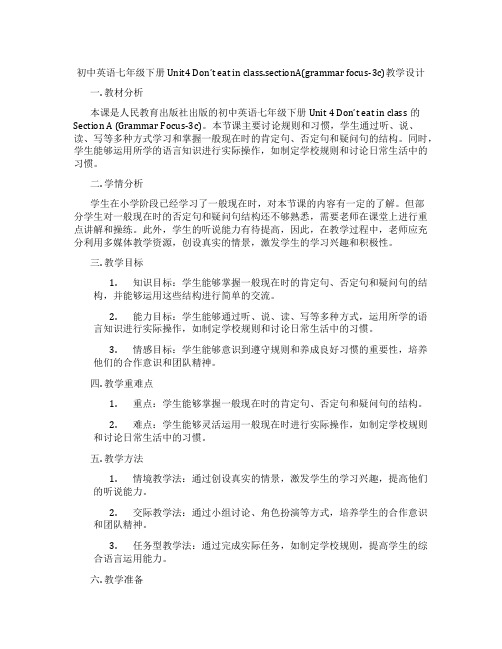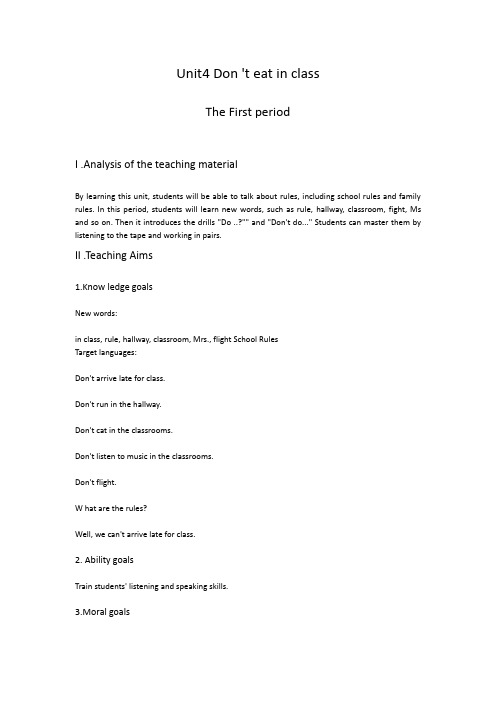《Don’t_eat_in_class》课时教学设计
- 格式:doc
- 大小:37.07 KB
- 文档页数:6

初中英语七年级下册Unit4 Don’t eat in class.sectionA(grammar focus-3c)教学设计一. 教材分析本课是人民教育出版社出版的初中英语七年级下册Unit 4 Don’t eat in class的Section A (Grammar Focus-3c)。
本节课主要讨论规则和习惯,学生通过听、说、读、写等多种方式学习和掌握一般现在时的肯定句、否定句和疑问句的结构。
同时,学生能够运用所学的语言知识进行实际操作,如制定学校规则和讨论日常生活中的习惯。
二. 学情分析学生在小学阶段已经学习了一般现在时,对本节课的内容有一定的了解。
但部分学生对一般现在时的否定句和疑问句结构还不够熟悉,需要老师在课堂上进行重点讲解和操练。
此外,学生的听说能力有待提高,因此,在教学过程中,老师应充分利用多媒体教学资源,创设真实的情景,激发学生的学习兴趣和积极性。
三. 教学目标1.知识目标:学生能够掌握一般现在时的肯定句、否定句和疑问句的结构,并能够运用这些结构进行简单的交流。
2.能力目标:学生能够通过听、说、读、写等多种方式,运用所学的语言知识进行实际操作,如制定学校规则和讨论日常生活中的习惯。
3.情感目标:学生能够意识到遵守规则和养成良好习惯的重要性,培养他们的合作意识和团队精神。
四. 教学重难点1.重点:学生能够掌握一般现在时的肯定句、否定句和疑问句的结构。
2.难点:学生能够灵活运用一般现在时进行实际操作,如制定学校规则和讨论日常生活中的习惯。
五. 教学方法1.情境教学法:通过创设真实的情景,激发学生的学习兴趣,提高他们的听说能力。
2.交际教学法:通过小组讨论、角色扮演等方式,培养学生的合作意识和团队精神。
3.任务型教学法:通过完成实际任务,如制定学校规则,提高学生的综合语言运用能力。
六. 教学准备1.教师准备:提前准备好教学课件、多媒体教学资源、教学卡片等。
2.学生准备:学生提前预习课本内容,了解一般现在时的基本结构。

Unit4 Don't eat in class. 教学设计教材分析:本课时语言目标是讨论规则,这一话题很贴近孩子们的实际生活,无论在家还是在学校,都有着许多规则,我们必须严格要求自己,遵守这些规则。
学情分析:学生们积极性高,大家心里都有依据,懂得该做的事情和不该做得事情。
能够运用Let's do sth.and have to do sth. 能够掌握祈使句表达句型,也有少部分同学会说不会写,需要多练习巩固。
教学目标1.复习、巩固祈使句的用法。
2.学习情态动词“can”表许可的用法。
教学重难点提示1.分析情态动词:can,have to的用法。
2.祈使句和“can't”句型在语气上的差异。
教学过程Section A1.教师进教室后,使用祈使句请学生们完成一些事情或动作。
【学生活动】同学们听老师的指令完成动作。
Please close the door.Open the window,please.Don't open your books.Please look at me and listen to me carefully.Let's begin our class.2.教师出示书上1a图片,把生词“hallway”板书在黑板上,教读。
【学生活动】学生识记生词“hallway”。
(1)指着图中男孩提问,学生举手回答:T:What's the boy doing?Where is he running?告诉学生:Don't run in the hallway.【学生活动】学生根据教师提问回答:S:He is running.He is running in the hallway.教师边说边把句子:You can't run in the hallway.并板书在黑板上,请学生跟读数遍。
(2)教师指着图中女孩,请一学生告诉全班这个女孩在干什么。

don't eat in class教案设计教案设计: 不要在课堂上吃东西教学目标:1. 学习和理解不要在课堂上吃东西的原因。
2. 培养学生良好的课堂行为和礼仪。
3. 引导学生意识到自己对学习的责任和重要性。
教学准备:1. PPT或黑板/白板。
2. 图片或视频示例。
3. 讨论和角色扮演活动所需的学生分组。
教学过程:1. 热身活动 (5分钟)- 向学生提问: 在课堂上吃东西有什么问题?- 引导学生讨论并回答问题,鼓励他们分享自己的看法和经验。
2. 呈现原因 (10分钟)- 展示图片或视频示例,展示在课堂上吃东西可能引发的问题,如分散注意力、打扰他人等。
- 鼓励学生思考其他可能的原因,并向他们提出问题,引导他们探索和讨论这些原因。
3. 讨论和角色扮演活动 (15分钟)- 将学生分成小组,让他们就在课堂上吃东西的问题展开讨论。
- 每个小组选择一种原因进行讨论,并通过角色扮演活动来展示这个问题的具体影响。
- 学生可以扮演吃东西的学生、被打扰的学生和老师等角色。
- 让学生通过角色扮演体验各种角色的想法和感受,并帮助他们理解为什么不要在课堂上吃东西。
4. 教育意义 (10分钟)- 引导学生思考和讨论在课堂上专心学习的重要性。
- 与学生分享专注学习的好处,如更好的理解课程、提高成绩和培养良好的学习习惯。
- 鼓励学生思考和制定个人学习目标,并与他们分享如何在课堂上保持专注和集中注意力的方法。
5. 总结和评估 (5分钟)- 回顾学生学习的重点和目标。
- 对学生进行简单的评估,例如提问一些有关在课堂上吃东西的问题,并让学生回答。
- 就本节课的教学效果进行反思,并鼓励学生提出自己的意见和建议。
扩展活动:1. 组织学生参观学校和社区图书馆,了解和体验不同场所的行为规范和礼仪。
2. 请来一位校长或老师进行专题讲座,讨论和分享课堂行为和礼仪的重要性。
3. 分角色扮演小组进行类似的教育主题,如不要在图书馆大声说话、尊重老师和同学等。

Unit4. Don’t eat in class. Section B 1a—2c【学习目标】一、知识目标:1. 掌握本课单词: dirty, kitchen, more, noisy, relax, read, terrible, feel, strict, remember, follow, luck2. 重点短语:make one’s bed, be strict (with sb.), follow the rules, too many rules, read a book, good luck,3. 重点句子:1) There are too many rules!2) Get up now and make your bed3) Don’t leav e the dirty dishes in the kitchen.4) I must read a book before I can watch TV.5) I know how you feel.6) You can watch TV after you read a book.二. 能力目标:1.读熟单词, 2.根据问题快速浏览信息的能力 3. 提取有效信息的能力。
三. 情感目标:1.试着站在家长,老师的角度看待家规,懂得“规则”的必要性2. 在遇到压力和烦恼时可以寻找心理医生等健康途径疏导,解决。
【教学方法】:讲练结合,听说结合【教学用具】:多媒体辅助教学【授课类型】:新授课【学习重点】1.重点词汇:dirty, kitchen, noisy, relax, read, terrible , strict remember, follow, luck2重点短语:read a book,make one’s bed, be strict (with sb.), follow the rules, too many rules【学习难点】1用目标语言谈论对某些规章制度(校规、家规等)的看法2. 重点语法知识点。

Unit 4 Don’t eat in class.The first period课型说明新授课,听说写课型年级七年级授课教师佛子岭中心校程先发教学目标1. 知识目标:单词: rule,arrive,classroom,hallway,outside ,fight ,dininghall,listen to.语言结构:Can we eat in class? No,we can’t.We can eat in the dining hall,but we can’t eat in the classroom.don’t eat in class.Can we fight in school? No,we can’tdon’t fight in school.can we arrive late for class? no,we can’t.don’t arrive late for class.2.能力目标:(1)能在相互地交流中运用本课单词和句型:运用所学英语谈论对某些规章制度(校规、家规)的看法。
(2)能够大胆、自然的用英文交谈,有表达的勇气和积极性,能做到语音、语调清晰。
3. 情感目标:(1).培养学生的人际交往,学会与他人合作.(2)让学生能较熟练地用英语表达一些标志的含义,能制定一些规章制度。
教学重难点总体上说:本单元的重、难点是让学生能较熟练地用英语表达一些标志的含义。
能自如地运用所学英语谈论对某些规章制度(校规、家规)的看法。
能使用目标语言制定并讨论校园内一些公共场所的规则。
重点词汇:rule,arrive,classroom,hallway,outside ,fight ,uniform ,sports shoes ,dining hall句型方面:don’t eat in class!don’t run in the hallways.don’t fight in school.难点:1. 语言功能:学会谈论一些规章制度。

Unit4 Don 't eat in classThe First periodI .Analysis of the teaching materialBy learning this unit, students will be able to talk about rules, including school rules and family rules. In this period, students will learn new words, such as rule, hallway, classroom, fight, Ms and so on. Then it introduces the drills "Do ..?"" and "Don't do..." Students can master them by listening to the tape and working in pairs.II .Teaching Aims1.Know ledge goalsNew words:in class, rule, hallway, classroom, Mrs., flight School RulesTarget languages:Don't arrive late for class.Don't run in the hallway.Don't cat in the classrooms.Don't listen to music in the classrooms.Don't flight.W hat are the rules?Well, we can't arrive late for class.2. Ability goalsTrain students' listening and speaking skills.3.Moral goalsAs students, we must obey school rules.II.Teaching important pointsThe school rules and the target language.IV.Teaching difficult pointsLearn to talk about the school rules.Train students' listening and speaking skills.V .Teaching methodsScene teaching method.Listening and oral practicing methods.VI.Teaching toolsPictures.A tape recorder.VlI.Teaching ProceduresStep l GreetingStep 2 RevisionReview some words and language points learned in Unit llStep 3 presentationFocus attention on the five rules written under "School Rules". Read the list to the class. Then read the list again, using simple explanations or acting out some rules to make clear the meaningof each one. For example, point to your watch: Class starts at 9:00. Don't arrive late for class 9:05 is late. 9:10 is late. If you come to class at 9:10, you are breaking the rules. 9:00 is not late. Don't arrive late for class. Rep at. Don't arrive late for class.Point out the students in the picture and the boxes next to them. Say, Each of these students is breaking one of these rules. Writ e the number of the rule each student is breaking in the box next to him or her. Point out the sample answer.Check the answers.(This activity introduces the key vocabulary.)Step 4 ListeningPoint to the five rules in activity la. Ask different students to read each rule to the class.Point to the picture. Ask different students to say the rules that t he students are breaking in the picture.Say, This conversation tells about three students. The students a re breaking rules. Point out the direction line and the space after each name. Say, Write the number of the rule next to the name of the student who is breaking that rule.Play the recording the first time. Students only listen.Play the recording a second time. As they listen to the recording this time, students fill in the number of the rule after each name.Correct the answers.(This activity gives students practice in understanding the target language in spoken conversation.)Step 5 pair workPoint out the example conversation. Ask two students to read the dialogue to the class.Say, Now work with a partner. Student A is from another country. He or she doesn't know the rules of this school. Student B tells him or her the rules from activity la.As the pairs talk, move around the room monitoring their work. Offer language or pronunciation support as needed.Ask several pairs to present one or more of their conversations t o the class.Say, Now let's talk about the rules of our school. Student B is fr om another country. Student A tells him or her about the rules 0 f our school.Again, move around the room monitoring progress and offering help as needed.(This activity provides guided oral practice using the target language.)Step 6 SummaryIn this class we have mainly learned to talk about school rules. A S students, we must obey school rules.Step 7 HomeworkWrite down the rules in activity la without looking at books.Blackboard DesignUnit 12 Don t eat in classl. New words: rule, hallway, classroom, Mrs., flight 2. Drills:Don't do sth.Don't eat in class.Don't play in class.教学反思:本节课的设计创设情景,鼓励学生大胆地使用英语,在教学过程中,每个需要把握的知识点,都给学生自主学习和直接交流的机会,以及充分表现和自我发展的一个空间。
Unit 4 Don’t eat in class.单元备课教学内容:本单元主要教会学生用英语谈论学校和家里的规章制度。
读懂关于家庭规章的文章,并熟练运用have to ,must, can ,can‟t 完成句子和文章。
写出家里和学校里的规章制度,然后谈谈个人感受。
培养学生自主学习和主动用英语进行交际的意识。
指导学生能够以书信的形式向别人描述自己身边的故障制度。
教学目标:知识与技能1.词汇:rules, arrive, late, hall, dinning hall, listen, listen to, fight, sorry, out, go out, dish, do the dishes, night, before, dirty, kitchen, more, noisy, relax, read, terrible, feel, strict, be strict with, remember, follow, follow the rules, luck2.句型:Don't eat in class!/Can we wear hats? No, we can't.We don't have to wear a school uniform.3.语言结构:①祈使句②情态动词can 表示许可的用法。
过程与方法:Listening and speaking practice ,reading and writing practice, pair work ,group work.情感态度与价值感:1.通过小组对话、讨论和调查等一系列的活动,培养学生的合作意识。
2.通过课堂上与外教的交流,让学生了解不同的国家的不同的文化,培养初步的跨文化交际能力。
教学重点:1词汇:rule, arrive, hall, listen, sorry, outside, fight, wear, important, bring, player, quiet, out, dish, night, before, dirty, kitchen, more, noisy, relax, read, terrible, feel, strict, remember,follow, luck, keep, hair, learn, dining hall.2句型:a、Don‟t …b、…can‟t/ have to/ must …3话题:Talk about rules.4语法:A 祈使句。
Unit;12;Don’t;eat;in;class.unit 12 don’t eat in class.一、教学内容:unit 12 don’t eat in class.【详细教学内容】〔一〕语言功能:talk about rules 谈论规章制度〔二〕目标语言:1. what are the rules at your school?don’t run in the hallways and don’t arrive late for class.2. can we eat in school?we can eat in the dinning hall, but we can’t eat in the classrooms.3. can you wear hats in school?yes, we can. / no, we can’t.4. do you have to wear a uniform at school? yes, we do. / no, we don’t.5. what else do you have to do ? we have to clean the classroom.〔三〕重点单词和词组1. in class 在课堂上〔反〕after classin the class 在班上,在班级上don’t look out of the window in class. 课上不要向窗外看。
she is one of the best students in the class. 她是班上最好的学生之一。
2. fight v. 打架,争吵fight with 和……打架the two boys fought with each other yesterday. 昨天这两个男孩打了一架。
n. 打架,争吵there was a fight between the two boys yesterday. 3. wash v. 洗,洗涤wash your face clean. 把你的脸洗干净。
Unit 4 Don’t eat in class.Learning Objectives一、Topics(话题):Rules二、Functions (功能)Talk about rules三、Structures (结构)1. Imperatives (Don’t)2. Can for permission3. Modal verbs have to, must四、Target Language (目标语言)Don’t eat in the classroom!We ca n’t arrive late for class.We must be on time.Can we wear a hat in class?Yes, we can./No, we can’t.We have to clean the classroom.We have to follow the rules.五、V ocabulary (词汇)rule, dish, night, luck, hair, arrive, listen, fight, wear, bring, practice, relax, read, feel, remember, follow, keep, learn, quiet, noisy, dirty, terrible, strictarrive late for class, be on time, listen to music, do the dishes, make your bed, be strict with …, follow the rules六、Skills (技能)Listening for key informationScanning in reading七、Recycling (复习巩固)go out, do your homework, watch TV, clean your room, help your mom make breakfast, in the evening, every Saturday八、教材分析这本教材的词汇量很大,有难度,但是,内容新颖,尤其是生动活泼的卡通化的画面,很符合七年级学生的年龄特点和心理特点,其中还囊括了丰富多彩的文化知识,以及合作探究的活动,十分贴近学生的实际生活经验。
Unit4《Don’t eat in class》七年级下册 Section B(3a-3c)
教
学
设
计
亳州市第十六中学武克玲
一、设计理念
本节课采用任务型教学途径,这种途径是以应用为动力,以应用为目的,以应用为核心的教学途径。
任务型教学是一种以人为本的,能体现语言价值的,先进的、有效的教学途径。
学生带着任务学习,在完成任务的过程中逐渐生成知识,形成技能。
本课将通过任务型教学,努力达到课堂活动目的。
本课的三个任务先以谈论有关学校和生活中的各项规章制度为话题,初步感受祈使句,以及如何表达规则;通过认图标,说出规则,然后阅读本课时的这封信,完成表格以及不同的练习,这样,通过完成一系列任务,即使学生学会了如何描述规章制度,又渗透了对学生的情感教育:通过对公共场所制定规章制度,培养学生遵守公德、爱护公物的美德。
同时,学生还可以学会发散思维,以扩展知识;口头及书面表达能力也可随之提高。
二、教学目标:
知识目标:能够识记并运用下列词汇和句型
单词:keep,hair,short
句型:Can you help me? I must do my homework.I never have
fun.What should I do?
能力目标:能熟练使用目标语言谈论某些规章制度。
能使用目标语言讨论校园内和一些公共场所的规则。
情感目标:(1)学会自觉遵守校规校纪,对校规校纪提出合理要求。
(2)鼓励学生养成良好的行为习惯和良好的道德品质。
三、教学重点和难点:
重点:掌握祈使语气的用法,以及包括情态动词Can,must, have to的用法,和各种可以用在表述规章制度的词汇和句型。
难点:情态动词的用法,以及祈使句与它的应答。
四、教学准备
多媒体课件,投影仪
五、教学过程:
Step 1:Warming up
Greeting with each other(设计意图:简单的问候与寒暄,可以消除师生之间的陌生感与紧张感,在轻松愉快的氛围中,很快的融入本节课的学习中。
)
Step2:Lead in
1.Show an apple to students.Ask them:
What’s this?
Can we eat the apple in class?(设计意图:借助实物这一直观性教具,充分调动学生多种感官的参与,使他们在看得见,摸得着的教学过程中学习知识,发展思维,培养能力,从而引入本单元的话题。
)
2.Show some pictures to the students.Ask them:
What do the signs mean?(设计意图:图片呈现,更形象直观,复习前面所学的词汇,为下面的新知呈现作好铺垫。
)
3.T:When you are not happy ,who do you like to talk to?(设计意图:
用问题导入新知,让学生带着问题进入下一环节的学习,充分调动学生学习的积
极性,培养学生主动思维的习惯和能力。
)
Step3:Presentation
1. Pre-reading
T:Look at the picture ,how does she feel? Discuss it with your
partners.(设计意图:直观的图片能调动学生的各种感官来感知和认识客观事
物,能充分发挥学生的想象能力,从而输出与本课时教学相关的知识。
)
2.In-reading
Read Zhao Pei’s letter ,and then complete Zhao Pei’s letter to
Dr.Know using have to/must,can or can’t(设计意图:让学生独自自主的
去阅读去完成任务,培养学生良好的学习习惯,以及形成有效的学习策略。
)
3.After-reading
1.Fill in the blanks with the information(信息) of Zhao Pei’s letter.
My name is Zhao Pei. Every morning, I have to ______ at six o’
clock. I have to ____a school uniform, and I have to_____ my hair
short. I can’t play with my friends after school because I must____ my
homework .I can’t ____on weekends either because I have to _______ play the piano. I never________ . What can I do?
2.Ask and answer
1.How does Zhao Pei feel?
2.When does Zhao Pei have to get up?
3.Why does she can’t play with her friends?
4.Can she relax on weekends?
5.What does she have to do on weekends?(设计意图:形式不同的练习,可以及时的检测学生的学习效果,有效的反馈本节课的新知,促进师生共同进步。
)
Step4.Practice
plete the chart with the rules in your home and school .
2.Write a letter to Dr. Know. Tell him about all the rules and how you feel about them.(设计意图:强化本节课的内容,并能在本节课的基础上有所
拓展。
)
Step5.Consolidation
Invite some students to read their letters.(设计意图:学的最终目
的是运用,是学以致用,用英语来进行交流与交际,培养学生综合语言运用能力。
)Step6.Homework
e can ,can’t , have to /must and don’t to write about the rules at school. Write at least(至少)five sentences .
2. Make five rules for your daily(日常的) life。
(设计意图:让学生
明白规则处处有,能够用目标语言制定校园,家庭和一些公共场所的规则,鼓励
学生养成良好的行为习惯和良好的道德品质。
)
六.板书设计
Unit 4 Don’t eat in class
Section B(3a-3c)
I never have fun. :
What should I do?(设计意图:条理清晰,层次分明的呈现出本节课的重点内容,让学生一目了然,加深学生的记忆力。
简单有效的评价,能调动学生学习和参与的积极性。
)
七.教学反思:
这节课是阅读课,课堂上主要训练学生的读写能力。
英语课堂最重要的是让学生开口说,让学生大胆地说,鼓励学生说,让学生在赞扬中说,用英语去完成任务,让学生用英语做事情,课堂上注重全面提高学生的英语综合运用能力。